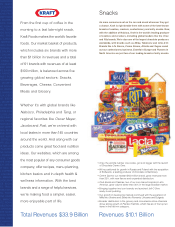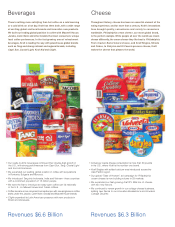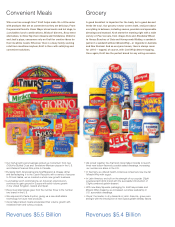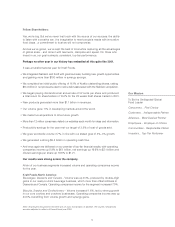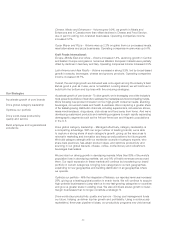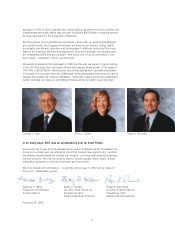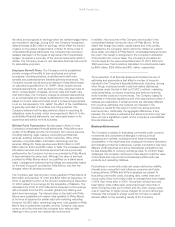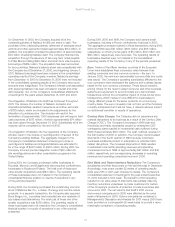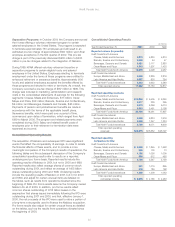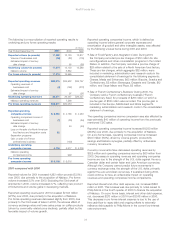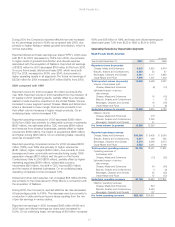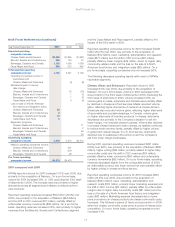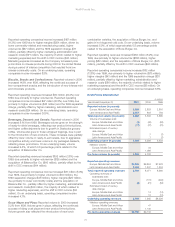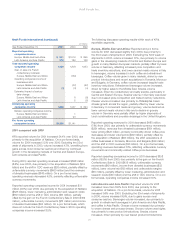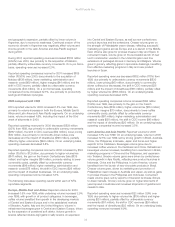Kraft 2001 Annual Report Download - page 28
Download and view the complete annual report
Please find page 28 of the 2001 Kraft annual report below. You can navigate through the pages in the report by either clicking on the pages listed below, or by using the keyword search tool below to find specific information within the annual report.
Kraft Foods Inc.
22
Management’s Discussion and Analysis
of Financial Condition and Results of Operations
Overview
Kraft Foods Inc. (“Kraft”), together with its subsidiaries (collectively
referred to as the “Company”) is the largest branded food and
beverage company headquartered in the United States. Prior to
June 13, 2001, the Company was a wholly-owned subsidiary of
Philip Morris Companies Inc. (“Philip Morris”). On June 13, 2001, the
Company completed an initial public offering (“IPO”) of 280,000,000
shares of its Class A common stock at a price of $31.00 per share.
The IPO proceeds, net of the underwriting discount and expenses,
of $8.4 billion were used to retire a portion of an $11.0 billion long-
term note payable to Philip Morris incurred in connection with the
acquisition of Nabisco Holdings Corp. (“Nabisco”). After the IPO,
Philip Morris owns approximately 83.9% of the outstanding shares
of the Company’s capital stock through its ownership of 49.5%
of the Company’s Class A common stock, and 100% of the
Company’s Class B common stock. The Company’s Class A
common stock has one vote per share while the Company’s Class
B common stock has ten votes per share. Therefore, Philip Morris
holds 97.7% of the combined voting power of the Company’s
outstanding common stock.
The Company conducts its global business through two units: Kraft
Foods North America, Inc. (“KFNA”) and Kraft Foods International,
Inc. (“KFI”). KFNA manages its operations by product category,
while KFI manages its operations by geographic region. KFNA’s
segments are Cheese, Meals and Enhancers; Biscuits, Snacks and
Confectionery; Beverages, Desserts and Cereals; and Oscar Mayer
and Pizza. KFNA’s food service business within the United States
and its businesses in Canada and Mexico are reported through
the Cheese, Meals and Enhancers segment. KFI’s segments are
Europe, Middle East and Africa; and Latin America and Asia Pacific.
Financial Reporting Release No. 60, which was recently issued
by the Securities and Exchange Commission (“SEC”), requires
all registrants to discuss critical accounting policies or methods
used in the preparation of financial statements. Note 2 to the
consolidated financial statements includes a summary of the
significant accounting policies and methods used in the preparation
of the Company’s consolidated financial statements. In the opinion
of management, the Company does not have any individual
accounting policy which is critical to the preparation of its
consolidated financial statements. This is due principally to the
definitive nature of accounting requirements for consumer products
companies. Also, in most instances, the Company must use
an accounting policy or method because it is the only policy or
method permitted under accounting principles generally accepted
in the United States of America (“U.S. GAAP”). The following is a
review of the more significant accounting policies and methods
used by the Company:
Revenue Recognition: As required by U.S. GAAP, the Company
recognizes operating revenues upon shipment of products to
customers when title and risk of loss pass to its customers.
Provisions and allowances for sales returns and bad debts are also
recorded in the Company’s consolidated financial statements. The
amounts recorded for these provisions and related allowances are
not significant to the Company’s consolidated financial position or
results of operations. As discussed in Note 2 to the consolidated
financial statements, effective January 1, 2002, the Company will
adopt new required accounting standards mandating that certain
costs currently reported as marketing, administration and research
costs be shown as a reduction of operating revenues or an
increase in cost of sales. As a result, previously reported revenues
will be reduced by approximately $4.6 billion, $3.6 billion and $3.4
billion for 2001, 2000 and 1999, respectively. The adoption of the
new accounting standards will have no impact on net earnings or
basic or diluted earnings per share.
Depreciation and Amortization: The Company depreciates
property, plant and equipment and amortizes goodwill and other
intangible assets using straight-line methods. Through December
31, 2001, the Company used forty years to amortize goodwill and
other intangible assets, in recognition of the strength of its brands,
which resulted in amortization expense of $962 million for the year
ended December 31, 2001. Beginning on January 1, 2002, with the
adoption of a new required accounting standard, the Company
will no longer be required to amortize a substantial portion of its
goodwill and other intangible assets. As a result, the Company
estimates that amortization expense will approximate $10 million
for the year ending December 31, 2002. The Company will also be
required to continue to review annually its goodwill and other
intangible assets for possible impairment or loss of value. However,
the Company does not currently anticipate having to record an
impairment loss when it adopts the new standard.
Marketing Costs: As required by U.S. GAAP, the Company
records marketing costs as an expense in the year to which such
costs relate. The Company does not defer the recognition of
any amounts on its consolidated balance sheet with respect to
marketing costs. The Company expenses advertising costs as
incurred in the period in which the related advertisement initially
appears. The Company records consumer incentive and trade
promotion costs as an expense in the period in which these
programs are offered, based on estimates of utilization and
redemption rates that are developed from historical information. As
discussed above under “Revenue Recognition,” beginning January
1, 2002, the Company will adopt the previously mentioned revenue
recognition accounting standards mandating that certain costs
currently reported as marketing expense be shown as a reduction
of operating revenues or an increase in cost of sales. As a result,
previously reported amounts for marketing, administration and
research costs will be reduced by approximately $4.7 billion, $3.7
billion and $3.4 billion for 2001, 2000 and 1999, respectively. The
adoption of the new accounting standards will have no impact on
net earnings or basic or diluted earnings per share.
Hedging Instruments: As of January 1, 2001, the Company
adopted the provisions of a new required accounting standard,
which did not have a material effect on net earnings (less than
$1 million) or accumulated other comprehensive losses (less than
$1 million). The new accounting standard requires that the fair value
of all derivative financial instruments be recorded on the Company’s
consolidated balance sheet as assets or liabilities. Substantially all
of the Company’s derivative financial instruments are effective as
hedges under the new standard; accordingly, the changes in their





